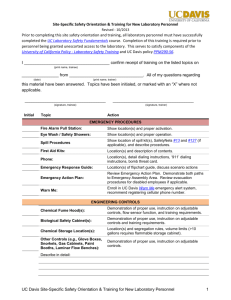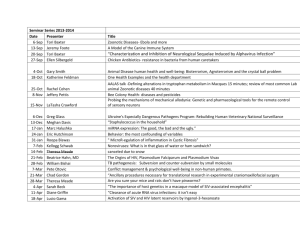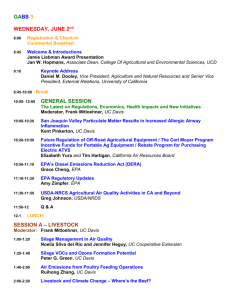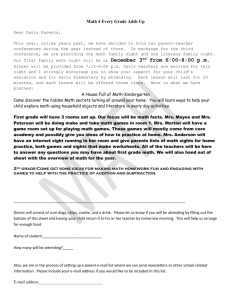Assignment 2 Final
advertisement
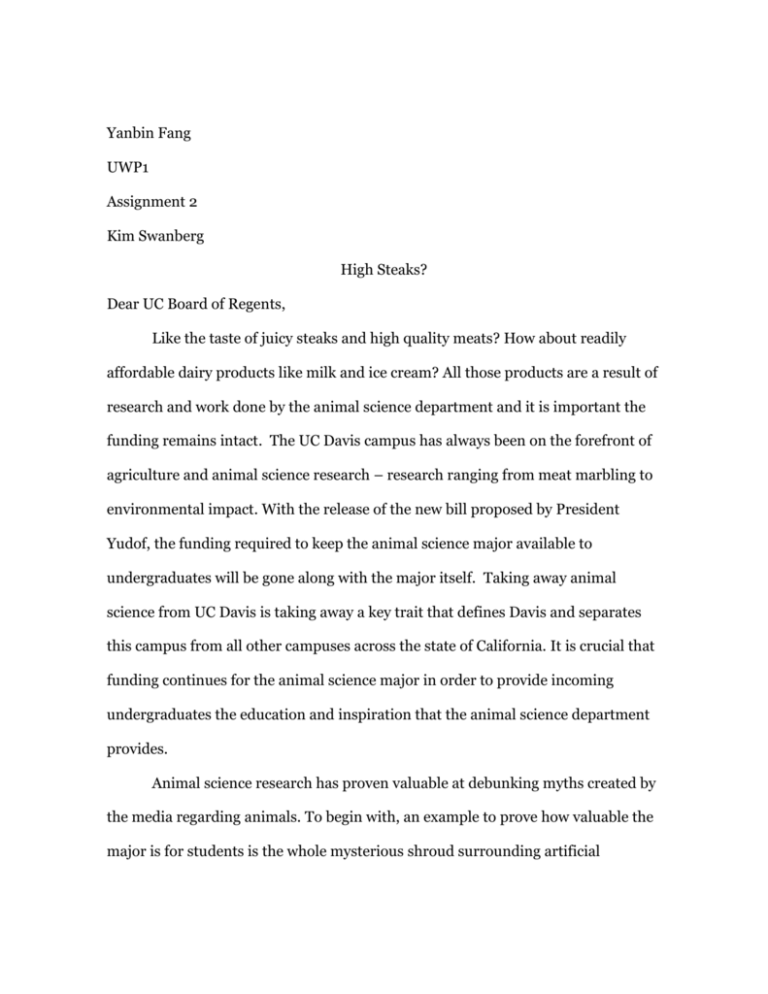
Yanbin Fang UWP1 Assignment 2 Kim Swanberg High Steaks? Dear UC Board of Regents, Like the taste of juicy steaks and high quality meats? How about readily affordable dairy products like milk and ice cream? All those products are a result of research and work done by the animal science department and it is important the funding remains intact. The UC Davis campus has always been on the forefront of agriculture and animal science research – research ranging from meat marbling to environmental impact. With the release of the new bill proposed by President Yudof, the funding required to keep the animal science major available to undergraduates will be gone along with the major itself. Taking away animal science from UC Davis is taking away a key trait that defines Davis and separates this campus from all other campuses across the state of California. It is crucial that funding continues for the animal science major in order to provide incoming undergraduates the education and inspiration that the animal science department provides. Animal science research has proven valuable at debunking myths created by the media regarding animals. To begin with, an example to prove how valuable the major is for students is the whole mysterious shroud surrounding artificial hormones in commercially available cow milk. While the incoming undergraduates may be unaware to the entire story behind the usage of artificial hormones in milk, lectures provided by Dr. Mitloehner, bring light on the truth behind such practices. The usage of hormones solely increases efficiency behind milk production without any side effects but the media focused solely on the negative connotation of “artificial hormones” and blew it completely out of proportion (Mitloehner, 2012). Without the major, young animal scientists wouldn’t be able to learn about controversies such as the usage of artificial hormones and the research done by the animal science department here to prove the safety behind it. However, the animal science major has so much more to offer. In addition to learning about the truth behind animal practices, undergraduates are also able to learn about and help professors research information that has a global impact. In an article on the UC Davis news named “Don’t Blame Cows for Climate Change,” Dr. Mitloehner explains the myths behind cows and greenhouse gas emissions along with the experiments he’s done to prove them wrong (Kerlin, 2009). He has successfully proven that beef cattle is not the major cause for global warming as pointed out by the United Nations’ published article, “Livestock’s long shadow.” In the published article, the UN states that “The Livestock sector is a major player, responsible for 18% of GHG emissions measured in CO2,” (FAO, 2006) However, Dr Mitloehner’s research with the help of undergraduates proved that the cattle and swine industry are actually only responsible for 3% of the nation’s greenhouse emissions while transportation accounts for a massive 27% (Mitloehner, 2012). The beauty behind this research is that many assistants in Mitloehner’s lab are either undergraduates from the animal science major who expressed interest in his work or graduate students who were influenced by his undergraduate animal science class, ANS 42. Students are able to see the importance behind the research done in the animal science department since Dr. Mitloehner’s work has proven to be vital for countries worldwide and he is now on the newly formed UN board to inform countries about agricultural emissions. Furthermore, the animal science major for undergraduates at UC Davis provides valuable hands on experience due to the research oriented nature of our campus. Students get to learn proper animal handling and safety precautions since many of the core agricultural animals are many times bigger than people. This is quite significant since improper handling can lead to not only compromising safety, but injuries to the animal as well as the handler. In just the introductory course offered here, ANS 1, Dr. Famula and his TAs teach handling techniques such as flipping sheep and handling mice (Famula, 2011). As expected, the welfare of the animals is a top priority and many of the animal science classes provide detailed explanations behind techniques and tricks that have been found the most effective. For example, it’s important that students approach all kinds of cattle from an angle visible to the cattle, and that each animal has its own flight zone that the handler must be conscious of. A legitimate concern however is that much of the basics can be taught at a technical school such as handling and that funding can be cut for the undergraduate program to save money. In addition, a Yahoo article written by Terence Loose states that there aren’t many jobs in the field for animal science graduates either (Loose, 2010). The problem here though is that it is through the undergraduate program where students see the passion that the professors have for their work and become inspired themselves. It’s important that we have a source of inspired young individuals coming from the undergraduate program that are able to work with the professors and researchers firsthand. In addition, there are things that undergraduates learn in the major that isn’t available in handling school. Professors go in depth into why the procedures are how they are and what they are and students get to understand the theory behind the practice. We have to take pride that UC Davis offers one of the best undergraduate animal science programs to provide the nation with the next generation of animal scientists. Last but not least, juicy steaks were mentioned and of course they cannot be forgotten in this discussion. While proper love and individual care can lead to high quality meats, such a method is unrealistic for feeding a country. In class, students learn that without breeding and animal science research, meat with more marbling would often resort in carcasses with very low yield in actual meat (Mitloehner, 2012). Instead, the cattle would end up with lots of fat outside the meat which is often not used for human consumption. Over the years, animal scientists and geneticists were able to breed and crossbreed cattle from different regions in order to maximize the efficiency of each head of cattle. What this means in English is that cattle would be able to produce higher quality meats with lots of marbling without sacrificing as much quantity. Overall, the animal science department has proudly represented UC Davis since it was founded with research that has put the nation on the forefront of agricultural efficiency and sustainability. It’s through the undergraduate program where students learn and appreciate all the research that has been applied in real world applications. It will be these students that will succeed and so it is absolutely crucial to provide them with the tools necessary to be the leaders of tomorrow. Works Cited Famula, Thomas. "Introduction to Sheep." Class Lecture. UC Davis, Davis. Fall 2011. Lecture. FAO. "Livestock's Long Shadow: Environmental Issues and Options." Livestock's Long Shadow: Environmental Issues and Options. United Nations, 2006. Web. 17 Feb. 2013. <http://www.fao.org/docrep/010/a0701e/a0701e00.HTM>. Kerlin, Kat, and Frank Mitloehner. "Don't Blame Cows for Climate Change :: UC Davis News & Information." UC Davis News & Information. UC Davis, 7 Dec. 2009. Web. 17 Feb. 2013. <http://www.news.ucdavis.edu/search/news_detail.lasso?id=9336>. Loose, Terence. "College Majors That Are Useless." Yahoo! Education. N.p., Sept. 2010. Web. 17 Feb. 2013. <http://education.yahoo.net/articles/most_useless_degrees.htm>. Mitloehner, Frank. "Animal Science Environmental Quality and Welfare." Class Lecture. UC Davis, Davis. Fall 2012. Lecture. Mitloehner, Frank. "Beef Nutrition." Class Lecture. UC Davis, Davis. Fall 2012. Lecture.

